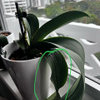oxalis growing questions
quinnfyre
15 years ago
Related Stories

KITCHEN DESIGN9 Questions to Ask When Planning a Kitchen Pantry
Avoid blunders and get the storage space and layout you need by asking these questions before you begin
Full Story
Design Dilemmas: 5 Questions for Design Stars
Share Your Design Know-How on the Houzz Questions Board
Full Story
GARDENING GUIDESNo-Regret Plants: 5 Questions Smart Shoppers Ask
Quit wasting money and time at the garden center. This checklist will ensure that the plants you're eyeing will stick around in your yard
Full Story
ORGANIZINGPre-Storage Checklist: 10 Questions to Ask Yourself Before You Store
Wait, stop. Do you really need to keep that item you’re about to put into storage?
Full Story
Design Dilemmas: 5 Questions for Houzzers!
Post Ideas for Landscaping for a Modern Home, Updating a Rental and More
Full Story
FEEL-GOOD HOMEThe Question That Can Make You Love Your Home More
Change your relationship with your house for the better by focusing on the answer to something designers often ask
Full Story
GREEN DECORATING8 Questions to Help You See Through Green Hype
With the ecofriendly bandwagon picking up some dubious passengers, here's how to tell truly green products and services from the imposters
Full Story
LANDSCAPE DESIGN7 Questions to Ask Before Laying Stepping Stones
These broken-up pathways invite you to put a spring in your step — while adding functionality to the garden
Full Story
REMODELING GUIDESConsidering a Fixer-Upper? 15 Questions to Ask First
Learn about the hidden costs and treasures of older homes to avoid budget surprises and accidentally tossing valuable features
Full Story
MOVINGHiring a Home Inspector? Ask These 10 Questions
How to make sure the pro who performs your home inspection is properly qualified and insured, so you can protect your big investment
Full Story








Mentha
tapla (mid-Michigan, USDA z5b-6a)
Related Professionals
Folsom Landscape Architects & Landscape Designers · West Chester Landscape Architects & Landscape Designers · Wixom Landscape Architects & Landscape Designers · White Oak Landscape Architects & Landscape Designers · Buford Landscape Contractors · Mooresville Landscape Contractors · Bedford Landscape Contractors · Cockeysville Landscape Contractors · Coeur d'Alene Landscape Contractors · Fort Payne Landscape Contractors · Milford Mill Landscape Contractors · Nashua Landscape Contractors · Reedley Landscape Contractors · Saint George Landscape Contractors · Barstow Interior Designers & DecoratorsquinnfyreOriginal Author
tapla (mid-Michigan, USDA z5b-6a)
birdsnblooms
quinnfyreOriginal Author
tapla (mid-Michigan, USDA z5b-6a)
quinnfyreOriginal Author